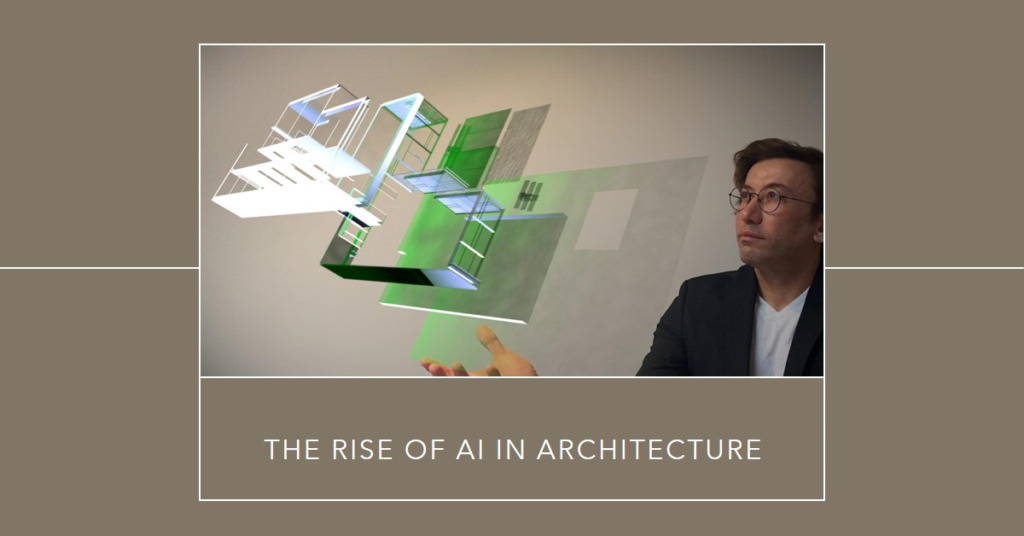
Table of Contents
Introduction: AI in Architecture
In the age of technological advancement, architecture stands at the forefront of innovation. The integration of Artificial Intelligence (AI) has transformed traditional architectural practices, ushering in a new era of efficiency, sustainability, and creativity. From conceptual design to construction management, AI algorithms are revolutionizing every aspect of the architectural process. In this blog post, we delve into the profound impact of AI on architecture, exploring its evolution, applications, and future prospects.
Evolution of AI in Architecture:
The journey of AI in architecture traces back to the early experiments with computational design tools in the 1960s. However, it wasn’t until recent decades that advancements in machine learning and data analytics accelerated its integration into architectural workflows. Initially, AI was primarily utilized for automation tasks such as drafting and modeling, streamlining repetitive processes and enhancing productivity. As computational power increased and algorithms became more sophisticated, AI’s role expanded beyond mere automation to encompass complex design optimization and analysis.
Applications of AI in Architectural Design:
AI has permeated every stage of architectural design, offering architects unprecedented capabilities to explore innovative concepts and solutions. In the conceptual phase, generative design algorithms leverage AI to generate myriad design iterations based on predefined parameters, enabling architects to explore a vast design space and discover novel solutions. These algorithms analyze data from various sources, including site conditions, environmental factors, and user preferences, to generate designs that are optimized for performance, sustainability, and human experience.
Integration of AI in Sustainable Design:
Sustainability has emerged as a paramount concern in contemporary architecture, and AI plays a pivotal role in advancing sustainable design practices. By harnessing AI-powered simulation tools, architects can assess the environmental performance of their designs with unprecedented accuracy. These tools simulate factors such as daylighting, energy consumption, and thermal comfort, allowing architects to optimize their designs for maximum energy efficiency and occupant comfort. Furthermore, AI algorithms can analyze vast datasets to identify sustainable materials, construction methods, and urban planning strategies, facilitating the creation of eco-friendly built environments.
Enhancing User Experience with AI:
User experience lies at the heart of architectural design, and AI offers architects invaluable insights into user behavior and preferences. Through data-driven analysis of user interactions and spatial configurations, architects can tailor their designs to meet the needs and aspirations of diverse user groups. AI-powered predictive modeling tools forecast future user demands and trends, enabling architects to design spaces that are adaptable and responsive to evolving requirements. Moreover, AI-driven design platforms facilitate real-time collaboration and feedback, empowering stakeholders to participate in the design process and contribute their expertise.


AI in Construction Management:
Efficient construction management is essential for realizing architectural designs on time and within budget, and AI is revolutionizing this aspect of the architectural process. AI-powered project management systems utilize data analytics and predictive modeling to optimize construction schedules, resource allocation, and cost estimation. By analyzing historical project data and identifying patterns, these systems can anticipate potential risks and delays, enabling proactive decision-making to mitigate them. Moreover, AI-driven robotics and automation technologies are transforming on-site construction processes, enhancing precision, safety, and productivity.
Challenges and Ethical Considerations:
Despite its transformative potential, the integration of AI in architecture presents a myriad of challenges and ethical considerations. One significant challenge is the potential displacement of traditional architectural roles due to automation. As AI algorithms take on increasingly complex tasks, there is a concern that architects may become marginalized or reduced to mere overseers of AI-driven processes. Moreover, ethical considerations regarding data privacy, bias, and accountability loom large in the AI-powered design ecosystem. Architects must navigate these challenges thoughtfully, ensuring that AI remains a tool for augmenting human creativity and expertise rather than replacing it.
Future Outlook:
Looking ahead, the future of AI in architecture is brimming with possibilities. As AI algorithms continue to evolve and adapt, they will empower architects to push the boundaries of design innovation further. From AI-generated virtual reality simulations to AI-driven robotic construction, the architectural landscape is poised for a paradigm shift. Moreover, the democratization of AI tools and technologies will democratize design, fostering greater collaboration and inclusivity within the architectural community. Ultimately, AI holds the promise of not only reshaping the physical fabric of our cities but also enriching the human experience within them.
Conclusion:
In conclusion, the rise of AI in architecture represents a watershed moment in the evolution of the built environment. From conceptualization to construction, AI is redefining the architectural process, enabling architects to create spaces that are not only aesthetically stunning but also sustainable, functional, and responsive to user needs. As we embrace this technological revolution, it is imperative to approach AI integration with mindfulness, ensuring that it serves as a catalyst for human creativity and innovation. By harnessing the power of AI, architects can chart a course towards a more sustainable, equitable, and inspiring built environment for generations to come.



